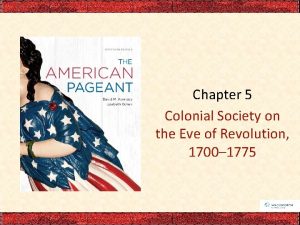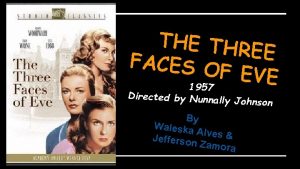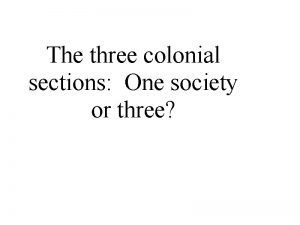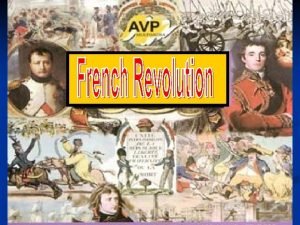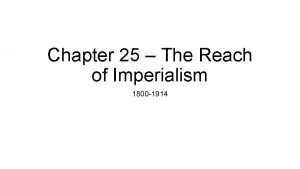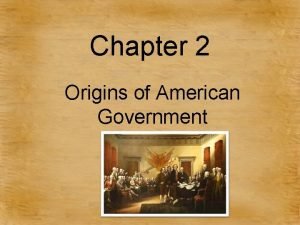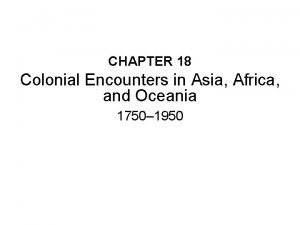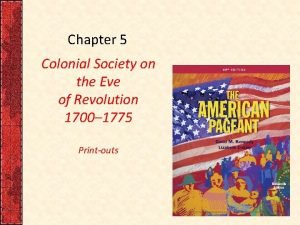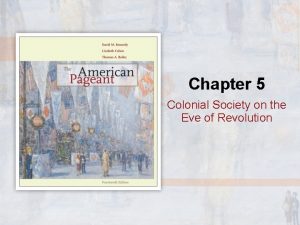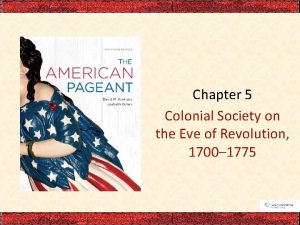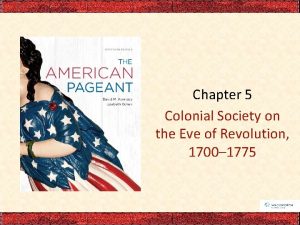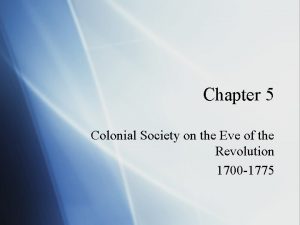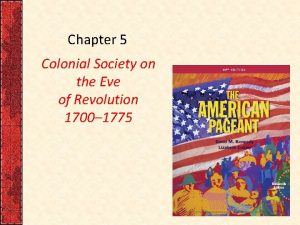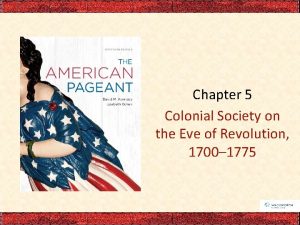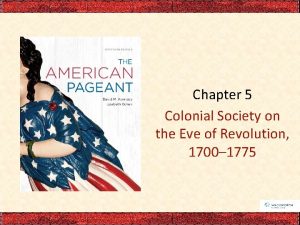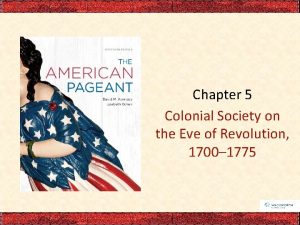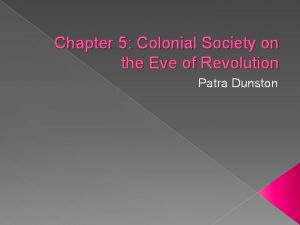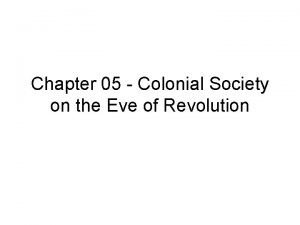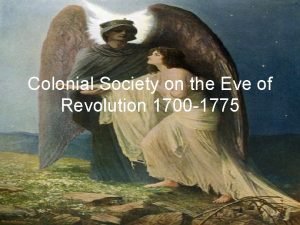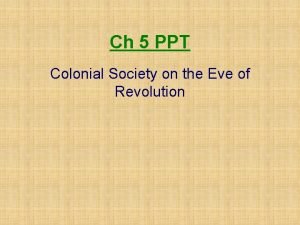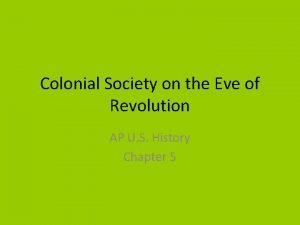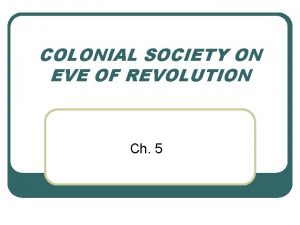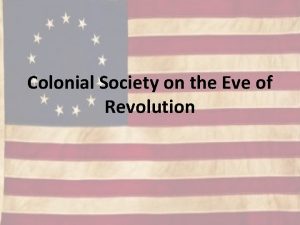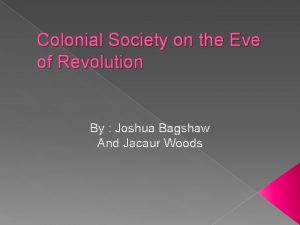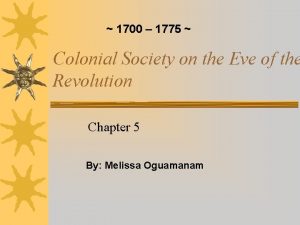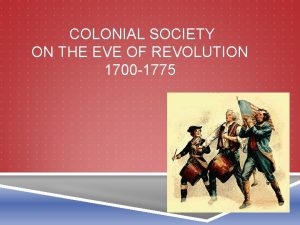Chapter 5 Colonial Society on the Eve of

























- Slides: 25

Chapter 5 Colonial Society on the Eve of Revolution

Characteristics that fueled the Rebellion • Native born population inreasing— 1700—less than 300, 000 people but by 1775— 2. 5 million people were in the colonies. “Americans multiplying like rattlesnakes” • Very young—average about 16

Colonial Diversity • Colonial America = melting pot of cultures • German (3% of population) in Pennsylvania • Scot-Irish (7% of population) squatted in west of Pennsylvania, frontiersmen, rickety settlements. Known to be Pugnacious, lawless, hotheads and individualistic • Other European groups (5 percent) • Africas— 20% of population, mostly in the South • New England was the least diverse • Multiculturalism laid the foundation of a melting pot society

Immigrant Groups in 1775 America was already a nation of diverse nationalities in the colonial period. This map shows the great variety of immigrant groups, especially in Pennsylvania and New York. It also illustrates the tendency of later arrivals, particularly the Scots-Irish, to push into the backcountry.

Ethnic and Racial Composition of the American People, 1790 Based on surnames. Source: Adapted from the American Council of Learned Societies, “Report of Committee on Linguistic and National Stocks in the Population of the United States, ” 1932. Percentages total more than 100 percent due to rounding.

Structure of Society • Equality and opportunity (except for slaves) • Most were rural farmers • Social Mobility (unlike England) • Wars led to some being in higher clases • In New England—land was no longer abundant, which led to poverty, homelessness • In Souht—wealth concentrated on a few rich landowners

The “riffraff” crowd • 50, 000 criminals deported from England to colonies • Robbers, rapists and murderers • Some became good citizens

A South Carolina Advertisement for Slaves in the 1760 s Note the reference to these slaves’ origin on West Africa’s “Rice Coast, ” a reminder of South Carolina’s reliance on African skill and labor for rice cultivation. Note, too, that half the slaves were said to have survived smallpox and thus acquired immunity from further infection—and that care had been taken to insulate the others from a smallpox epidemic apparently then raging in Charleston.

Slaves • African American slaves were at the bottom of society • Their large numbers, especially in South created the fear of armed rebellion

Agriculture • 90% of people were farmers • Maryland Virginia—Tobacco • Middle Colonies—grain colonies • New England—Fishing and shipbuilding • Triangle Trade very profitable for colonists • New England, New York and Pennsylvannia became increasingly wealthy • Household weaving/Lumbering became increasingly profitable.



Triangle Trade • At first only with Britain, with time America looked for other markets to sell goods. • Trade began with France and West Indies • ***Molasses Act is passed—English parliament imposes huge tax on sugar coming from the French and other non English West Indies—Colonists begin to get angrier. • America’s Revolution begins at the Taverns


Sign of the Pine Tree Inn, 1768 Inns like Joseph Read III’s in Lisbon, Connecticut, not only provided food, drink, shelter, and entertainment for colonial Americans but also were raucous arenas for debating political issues. This sign, with its circular yellow orb (sun) over a pine tree, may have been intended as a veiled reference to the Sons of Liberty, an extralegal resistance organization that had adopted as its symbol the Liberty Tree. The date of 1768 coincided with the British enactment of the Townshend Acts, which ignited a new wave of colonial resistance to British rule.

Religion , the Revolution & the Great Awakening • Religious Freedom expanded as the colonies expanded. • Revolutionary rhetoric (speech) was usually heard from the pulpit • As time went on, the Puritan church became less “strict” on their ideology—liberal ideas challenged the “old timers” • Predestination was questioned and replaced with Arminianism, where all could go to heaven if they lead a good life, accpeted God’s grace. • 1730 s and 1740 s—Great Awakening—Jonathan Edwards and George Whitefield lead the Awakening. —Their style of preaching began changing the colonies’ minds on religion and conversion. Very emotional, “theatrical” conversions/preaching style.

Great Awakening • First mass movement in the colonies • “New Light” Centers created—Princeton, Brown, Rutgers, Dartmouth • United people based on common experiences, history.

George Whitefield Preaching Americans of both genders and all races and regions were spellbound by Whitefield’s emotive oratory.

Schools & Colleges • England—Education was only for aristocrats, for leadership and only for males. • Education especially important for New England (i. e. Harvard) • South—spread over large areas, mostly rural did not have many schools—only private tutors for the “few” • Focus of schools—religion, Latin, Greek, religious dogma • College education—to prepare men for ministry

The College of New Jersey at Princeton, 1764 Later known as Princeton University, it was chartered in 1746 by the Presbyterian Synod, though open to students of all religious persuasions. The fourth college to be founded in British North America, it met in Elizabeth and Newark, New Jersey, until a gift of ten acres of land precipitated a move to Princeton in 1756. All classes were held in the large building, Nassau Hall. Here the Continental Congress met for three months during the summer of 1783, making Princeton for a short time the capital of the nation…

Provincial Culture • Much of the Art/Architecture was brought here to the “New World” • Franklin’s Poor Richard’s Almanack— widely read, had advice/ moral stories, shaped America’s character • Franklin—most important scientist in America

Pioneer Presses • 1776—some privately supported libraries in colonies • Hand operated presses created pamphlets, leaflets and journals (revolution would be impossible without this) • “News” lagged weeks behind • Somewhat open discussion was tolerated (not yet full freedom of the press)

Colonial Craftsmanship In the “Pennsylvania Dutch” country, parents gave daughters painted wooden chests to hold their precious dowry linens at marriage. The horsemen, unicorns, and flower patterns on this dower chest confirm its origins in Berks County, Pennsylvania.

“The Magnetic Dispensary, ” ca. 1790 This British painting made sport of the era’s faddish preoccupations with electricity. Following Franklin’s experiments, static electricity, generated here by the machine on the right, was employed for “medicinal” purposes as well as for tingling entertainments.

The Popular Game of Billiards Most likely brought over by Dutch and English settlers, billiards provided amusement in local taverns throughout the colonies. By the nineteenth century, Americans, like the British and French who had long dominated the sport, had become obsessed with these games of cues and balls. The most popular form of pool, eight ball, was not invented until 1900.
 Chapter 5 colonial society on the eve of revolution
Chapter 5 colonial society on the eve of revolution Colonial society on the eve of revolution
Colonial society on the eve of revolution Colonial society on the eve of revolution
Colonial society on the eve of revolution Eve white, eve black y jane
Eve white, eve black y jane The three colonial sections-one society or three
The three colonial sections-one society or three The divisions in spanish colonial society 1789
The divisions in spanish colonial society 1789 Revolutionary princess eve chapter 5
Revolutionary princess eve chapter 5 Gertler econ
Gertler econ Chapter 25 lesson 1 colonial rule in southeast asia
Chapter 25 lesson 1 colonial rule in southeast asia Origins of american government chapter 2
Origins of american government chapter 2 Chapter 18 colonial encounters in asia and africa
Chapter 18 colonial encounters in asia and africa Lesson 1 colonial economy
Lesson 1 colonial economy Hình ảnh bộ gõ cơ thể búng tay
Hình ảnh bộ gõ cơ thể búng tay Lp html
Lp html Bổ thể
Bổ thể Tỉ lệ cơ thể trẻ em
Tỉ lệ cơ thể trẻ em Gấu đi như thế nào
Gấu đi như thế nào Tư thế worms-breton
Tư thế worms-breton Hát lên người ơi alleluia
Hát lên người ơi alleluia Các môn thể thao bắt đầu bằng tiếng chạy
Các môn thể thao bắt đầu bằng tiếng chạy Thế nào là hệ số cao nhất
Thế nào là hệ số cao nhất Các châu lục và đại dương trên thế giới
Các châu lục và đại dương trên thế giới Công thức tiính động năng
Công thức tiính động năng Trời xanh đây là của chúng ta thể thơ
Trời xanh đây là của chúng ta thể thơ Cách giải mật thư tọa độ
Cách giải mật thư tọa độ Phép trừ bù
Phép trừ bù
